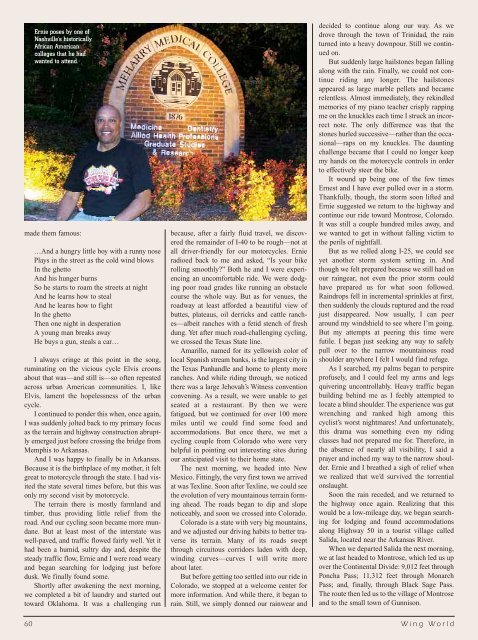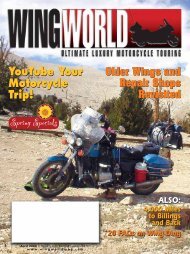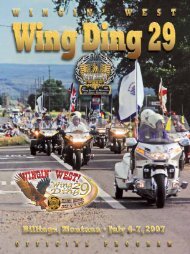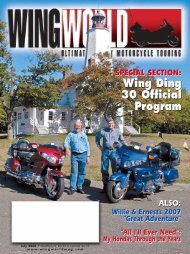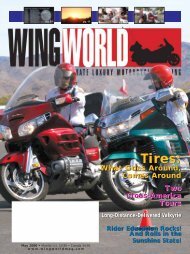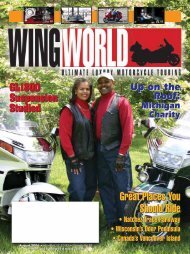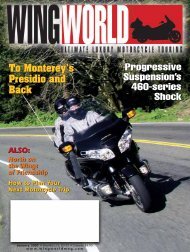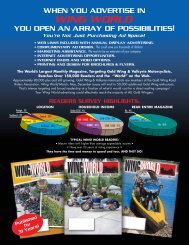to view pdf file of current issue - Wing World Magazine Archives
to view pdf file of current issue - Wing World Magazine Archives
to view pdf file of current issue - Wing World Magazine Archives
You also want an ePaper? Increase the reach of your titles
YUMPU automatically turns print PDFs into web optimized ePapers that Google loves.
Ernie poses by one <strong>of</strong><br />
Nashville’s his<strong>to</strong>rically<br />
African American<br />
colleges that he had<br />
wanted <strong>to</strong> attend.<br />
made them famous:<br />
…And a hungry little boy with a runny nose<br />
Plays in the street as the cold wind blows<br />
In the ghet<strong>to</strong><br />
And his hunger burns<br />
So he starts <strong>to</strong> roam the streets at night<br />
And he learns how <strong>to</strong> steal<br />
And he learns how <strong>to</strong> fight<br />
In the ghet<strong>to</strong><br />
Then one night in desperation<br />
A young man breaks away<br />
He buys a gun, steals a car…<br />
I always cringe at this point in the song,<br />
ruminating on the vicious cycle Elvis croons<br />
about that was—and still is—so <strong>of</strong>ten repeated<br />
across urban American communities. I, like<br />
Elvis, lament the hopelessness <strong>of</strong> the urban<br />
cycle.<br />
I continued <strong>to</strong> ponder this when, once again,<br />
I was suddenly jolted back <strong>to</strong> my primary focus<br />
as the terrain and highway construction abruptly<br />
emerged just before crossing the bridge from<br />
Memphis <strong>to</strong> Arkansas.<br />
And I was happy <strong>to</strong> finally be in Arkansas.<br />
Because it is the birthplace <strong>of</strong> my mother, it felt<br />
great <strong>to</strong> mo<strong>to</strong>rcycle through the state. I had visited<br />
the state several times before, but this was<br />
only my second visit by mo<strong>to</strong>rcycle.<br />
The terrain there is mostly farmland and<br />
timber, thus providing little relief from the<br />
road. And our cycling soon became more mundane.<br />
But at least most <strong>of</strong> the interstate was<br />
well-paved, and traffic flowed fairly well. Yet it<br />
had been a humid, sultry day and, despite the<br />
steady traffic flow, Ernie and I were road weary<br />
and began searching for lodging just before<br />
dusk. We finally found some.<br />
Shortly after awakening the next morning,<br />
we completed a bit <strong>of</strong> laundry and started out<br />
<strong>to</strong>ward Oklahoma. It was a challenging run<br />
because, after a fairly fluid travel, we discovered<br />
the remainder <strong>of</strong> I-40 <strong>to</strong> be rough—not at<br />
all driver-friendly for our mo<strong>to</strong>rcycles. Ernie<br />
radioed back <strong>to</strong> me and asked, “Is your bike<br />
rolling smoothly” Both he and I were experiencing<br />
an uncomfortable ride. We were dodging<br />
poor road grades like running an obstacle<br />
course the whole way. But as for venues, the<br />
roadway at least afforded a beautiful <strong>view</strong> <strong>of</strong><br />
buttes, plateaus, oil derricks and cattle ranches—albeit<br />
ranches with a fetid stench <strong>of</strong> fresh<br />
dung. Yet after much road-challenging cycling,<br />
we crossed the Texas State line.<br />
Amarillo, named for its yellowish color <strong>of</strong><br />
local Spanish stream banks, is the largest city in<br />
the Texas Panhandle and home <strong>to</strong> plenty more<br />
ranches. And while riding through, we noticed<br />
there was a large Jehovah’s Witness convention<br />
convening. As a result, we were unable <strong>to</strong> get<br />
seated at a restaurant. By then we were<br />
fatigued, but we continued for over 100 more<br />
miles until we could find some food and<br />
accommodations. But once there, we met a<br />
cycling couple from Colorado who were very<br />
helpful in pointing out interesting sites during<br />
our anticipated visit <strong>to</strong> their home state.<br />
The next morning, we headed in<strong>to</strong> New<br />
Mexico. Fittingly, the very first <strong>to</strong>wn we arrived<br />
at was Texline. Soon after Texline, we could see<br />
the evolution <strong>of</strong> very mountainous terrain forming<br />
ahead. The roads began <strong>to</strong> dip and slope<br />
noticeably, and soon we crossed in<strong>to</strong> Colorado.<br />
Colorado is a state with very big mountains,<br />
and we adjusted our driving habits <strong>to</strong> better traverse<br />
its terrain. Many <strong>of</strong> its roads swept<br />
through circui<strong>to</strong>us corridors laden with deep,<br />
winding curves—curves I will write more<br />
about later.<br />
But before getting <strong>to</strong>o settled in<strong>to</strong> our ride in<br />
Colorado, we s<strong>to</strong>pped at a welcome center for<br />
more information. And while there, it began <strong>to</strong><br />
rain. Still, we simply donned our rainwear and<br />
decided <strong>to</strong> continue along our way. As we<br />
drove through the <strong>to</strong>wn <strong>of</strong> Trinidad, the rain<br />
turned in<strong>to</strong> a heavy downpour. Still we continued<br />
on.<br />
But suddenly large hails<strong>to</strong>nes began falling<br />
along with the rain. Finally, we could not continue<br />
riding any longer. The hails<strong>to</strong>nes<br />
appeared as large marble pellets and became<br />
relentless. Almost immediately, they rekindled<br />
memories <strong>of</strong> my piano teacher crisply rapping<br />
me on the knuckles each time I struck an incorrect<br />
note. The only difference was that the<br />
s<strong>to</strong>nes hurled successive—rather than the occasional—raps<br />
on my knuckles. The daunting<br />
challenge became that I could no longer keep<br />
my hands on the mo<strong>to</strong>rcycle controls in order<br />
<strong>to</strong> effectively steer the bike.<br />
It wound up being one <strong>of</strong> the few times<br />
Ernest and I have ever pulled over in a s<strong>to</strong>rm.<br />
Thankfully, though, the s<strong>to</strong>rm soon lifted and<br />
Ernie suggested we return <strong>to</strong> the highway and<br />
continue our ride <strong>to</strong>ward Montrose, Colorado.<br />
It was still a couple hundred miles away, and<br />
we wanted <strong>to</strong> get in without falling victim <strong>to</strong><br />
the perils <strong>of</strong> nightfall.<br />
But as we rolled along I-25, we could see<br />
yet another s<strong>to</strong>rm system setting in. And<br />
though we felt prepared because we still had on<br />
our raingear, not even the prior s<strong>to</strong>rm could<br />
have prepared us for what soon followed.<br />
Raindrops fell in incremental sprinkles at first,<br />
then suddenly the clouds ruptured and the road<br />
just disappeared. Now usually, I can peer<br />
around my windshield <strong>to</strong> see where I’m going.<br />
But my attempts at peering this time were<br />
futile. I began just seeking any way <strong>to</strong> safely<br />
pull over <strong>to</strong> the narrow mountainous road<br />
shoulder anywhere I felt I would find refuge.<br />
As I searched, my palms began <strong>to</strong> perspire<br />
pr<strong>of</strong>usely, and I could feel my arms and legs<br />
quivering uncontrollably. Heavy traffic began<br />
building behind me as I feebly attempted <strong>to</strong><br />
locate a blind shoulder. The experience was gut<br />
wrenching and ranked high among this<br />
cyclist’s worst nightmares! And unfortunately,<br />
this drama was something even my riding<br />
classes had not prepared me for. Therefore, in<br />
the absence <strong>of</strong> nearly all visibility, I said a<br />
prayer and inched my way <strong>to</strong> the narrow shoulder.<br />
Ernie and I breathed a sigh <strong>of</strong> relief when<br />
we realized that we’d survived the <strong>to</strong>rrential<br />
onslaught.<br />
Soon the rain receded, and we returned <strong>to</strong><br />
the highway once again. Realizing that this<br />
would be a low-mileage day, we began searching<br />
for lodging and found accommodations<br />
along Highway 50 in a <strong>to</strong>urist village called<br />
Salida, located near the Arkansas River.<br />
When we departed Salida the next morning,<br />
we at last headed <strong>to</strong> Montrose, which led us up<br />
over the Continental Divide: 9,012 feet through<br />
Poncha Pass; 11,312 feet through Monarch<br />
Pass; and, finally, through Black Sage Pass.<br />
The route then led us <strong>to</strong> the village <strong>of</strong> Montrose<br />
and <strong>to</strong> the small <strong>to</strong>wn <strong>of</strong> Gunnison.<br />
60 <strong>Wing</strong> <strong>World</strong>


